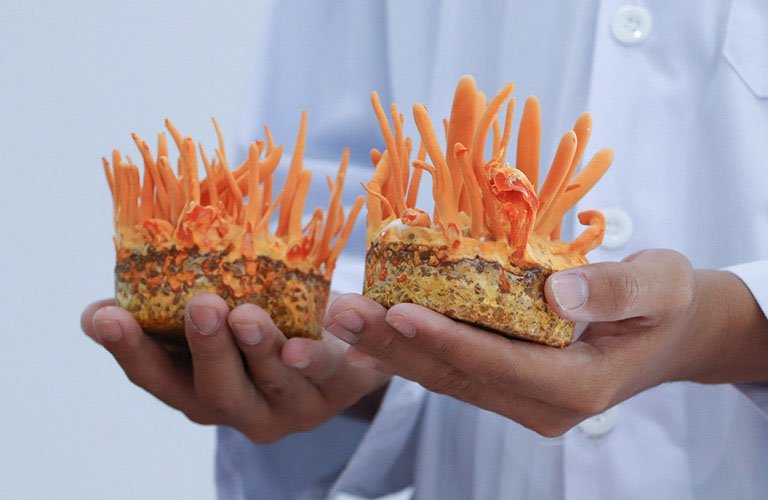What is Artificial Cordyceps Militaris?
Artificial cordyceps is currently a growing trend that has gained significant attention from customers. Not only is it more affordable, but its quality also meets standards, ensuring better health benefits for consumers. Let’s explore the following article to discover the outstanding features of artificial cordyceps! What is Artificial Cordyceps? As the name suggests, artificial cordyceps refers to cordyceps that are cultivated by humans under controlled conditions to produce a product with quality comparable to that of natural cordyceps, which are often expensive and rare. Scientists have researched and developed artificial cordyceps by inoculating Cordyceps militaris spores onto silkworm pupae, stink bugs, cicadas, or even brown rice. This process ensures the production of high-quality artificial cordyceps. The inoculation process takes place in glass containers under regulated conditions of temperature, humidity, and light, which are sealed to create an optimal environment for growth. This method ensures the cordyceps achieve the same quality as those found in high-altitude mountainous regions. Characteristics of Artificial Cordyceps Cordyceps Cultivated on Silkworm Pupae or Cicadas This is one of the most valuable research achievements in artificial cordyceps cultivation, producing a product that closely resembles natural cordyceps. This type of artificial cordyceps features a body with a yellowish-orange color. The fungal stem grows directly from the pupae or cicada body, creating a structure similar to the natural variety. Among all artificially cultivated cordyceps, this type is the most expensive due to its high resemblance to the natural counterpart. Cordyceps Cultivated on Substrates In this cultivation method, the appearance of the product is slightly different from that of the first type, but the nutritional content remains abundant. The fungal stems are typically yellow-orange in color, with a natural aroma and flavor, making them easy to use. Characteristics of Artificial Cordyceps Appearance Artificial cordyceps also have a worm-like shape, but they are not as thin and slender as natural cordyceps. This is because natural cordyceps typically grow in harsher environments, making them leaner. Being cultivated in controlled, optimal conditions, artificial cordyceps have a fuller and rounder appearance compared to their wild counterparts. Cordyceps cultivated on silkworm pupae or cicadas have a yellow-brown or dark yellow body, resembling the larvae-like shape of natural cordyceps, though not an exact replica. Artificial cordyceps cultivated with fungal spores feature an orange-yellow body with a club-shaped fungal head growing from the inoculation point. On the other hand, cordyceps grown on brown rice develop an orange color that extends from the base upward. Nutritional Content The nutritional content of artificial cordyceps is considered comparable to that of natural cordyceps. These nutrients are highly beneficial for enhancing immunity and improving overall health. Moreover, artificial cordyceps are significantly more affordable than natural ones, making them a popular choice for individuals seeking to improve their health and well-being. Growth Conditions The growth process of artificial cordyceps is relatively simpler compared to that of natural cordyceps. This process takes approximately three months to produce high-quality artificial cordyceps. The cultivation is conducted in laboratory conditions that simulate the natural environment in which cordyceps grow. Initially, stem cells are inoculated onto a fungal substrate and placed in a dark room, mimicking the natural hibernation phase. Subsequently, the substrate containers are moved to a brightly lit room to promote the formation of fruiting bodies and further growth. This entire process is carried out in a closed system, adhering strictly to food safety and hygiene standards to ensure the highest quality of the final product. The information above highlights some essential aspects of artificial cordyceps. Hopefully, it has addressed any concerns you may have had regarding its nutritional content or safety standards. We hope this knowledge serves as a helpful foundation for you to select the right product for yourself and your family.


